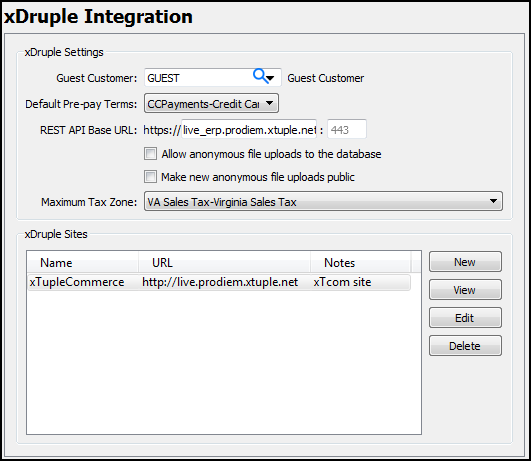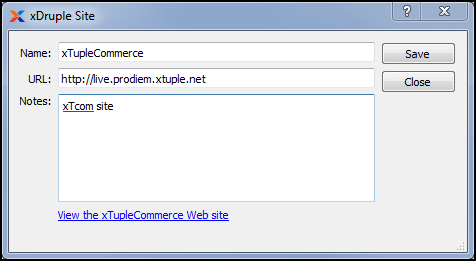
|
xTupleCommerce Product Guide |
To connect xTuple ERP and the xTupleCommerce web portal, you'll need to configure the xDruple integration settings within the ERP. This can be done by navigating to . Once the connection is configured, it is unlikely you will need to update it again. In fact, changing these settings would break the connection between the ERP and the web portal and should only be done under the advisement of your xTuple technical resource. Here's a screenshot showing what the xTuple Integration screen looks like:

xDruple Integration screen
When configuring the xDruple integration, you are presented with the following options:
Choose the customer record you want to use as the proxy for anonymous users visiting your site. Even if you don't allow anonymous users to make purchases, you still need to define the default guest customer record. Anonymous users inherit the guest customer's privileges, when it comes to viewing product information coming from the ERP. To learn more about how to create and set up the guest customer, please see Section 7, “Creating the Guest Customer”.
Choose the default terms to be used for pre-payments (i.e., credit card payments) on your web portal. Since this will be the default terms presented on your site, you may want to create a unique terms record just for the web portal. Examples might include "CC-Prepay with Credit Card" or "Credit Card Online." You can read more about this in Section 9, “Creating Billing Terms”.
Enter the URL indicating the location of the REST API, followed by the port number for the secure Node.js connection.
There may be cases where you want anonymous users to upload files (e.g., PDFs, JPEGs) via a web form on the site. Selecting this option enables anonymous users to do this. Files uploaded in this way will be saved to the ERP database. If not selected, users will have to log in to upload files.
You should not use the public option unless you have a specific use case for it. The concern is that people could attempt to upload malicious files. So it would be wise to leave this checkbox as disabled until the specific use case has been throughly thought through.
When files are uploaded, they can be either private or public. If they are private, only the user who uploaded the file can access the file, as well as the ERP admin. If the files are public, then anyone with access to the file (via URL) can see it. You should not use the public option if customers will be uploading sensitive data, such as company or financial information.
Select the tax zone which will give you the maximum tax coverage for orders placed by users who don't already have a tax zone defined (e.g., anonymous users). This feature takes effect if the tax region assignment fails to find a match based on the user's address. The maximum tax zone is a kind of final safety net, ensuring you earmark enough funds to cover taxes when user credit cards are pre-authorized. Later, when the underlying sales order is processed, the correct tax zone can be set, causing the correct amount of tax to be charged. Sales orders inheriting the maximum tax zone will be flagged as on "tax hold" for identification purposes. For more information, please see Section 11, “Tax Regions Setup”.
This is a list showing the xTupleCommerce sites the ERP is currently connected to. In most cases, there will only be one site listed. The following screen shows the set up detail for an xDruple site:

xDruple Site screen